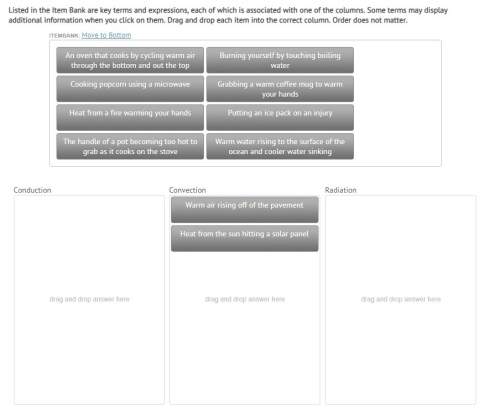:( asap! list all of the items in the item bank and match the definitions correctly.
...

Physics, 21.06.2019 14:30 derick5977
:( asap! list all of the items in the item bank and match the definitions correctly.


Answers: 2


Another question on Physics

Physics, 22.06.2019 07:10
1. how much energy is needed to raise the temperature of 40.0 g of argon from 25c to 40c? the specific heat capacity of argon is 0.520 j/(g·k) 2a. 23.0 ml of 0.100 m hcl (standard) are added from a buret to neutralize 50.0 ml of an unknown basic solution. 2b. if the oh- produced in the previous reaction came from ca(oh)2, then what is the molarity of the ca(oh)2? 3.calculate the new freezing-point of a solution when 60.5 grams of cacl2 solute is dissolved in 0.612 kg of water. 4. what is the maximum number of moles of alcl3 that can be produced from 5.0 mol al and 6.0 mol cl2? 5. a sample of oxygen gas has a volume of 150 ml when its pressure is 0.923 atm. if the pressure is increased to 0.987 atm and the temperature remains constant, what will the new volume be? 6. nitrogen gas in a closed container at a temperature of 100.0 oc and 3.0 atm is heated to 300 oc. what is the pressure of the gas at the higher temperature?
Answers: 3

Physics, 22.06.2019 16:50
Abird flies directly overhead from where you stand at an altitude of 300.0 m and at a speed horizontal to the ground of 20.0 m/s. the bird has a mass of 2.0 kg. the radius vector to the bird makes an angle \thetaθ with respect to the ground. the radius vector to the bird and its momentum vector lie in the xyxy-plane. what is the bird’s angular momentum about the point where you are standing?
Answers: 2

Physics, 22.06.2019 18:00
Cells in the nervous system have a potential difference of 70 mv across the cell membrane separating the interior of the cell from the extracellular fluid. this potential difference is maintained by ion pumps that move charged ions across the membrane. is this an emf? select the correct answer and explanation. 1)no. the ion pumps cannot separate charges; thus, they cannot create a potential difference. 2)yes. the ion pumps cannot separate charges, but they still can create a potential difference. 3)yes. the ion pumps can actively separate charge; thus, they can create a potential difference. 4)no. the ion pumps can separate charges, but they cannot create a potential difference.
Answers: 1

Physics, 23.06.2019 00:00
You notice the birds sitting on the electrical wires which of the following explain why the birds don't get shocked
Answers: 2
You know the right answer?
Questions



Mathematics, 09.10.2019 04:10


History, 09.10.2019 04:10

History, 09.10.2019 04:10

Mathematics, 09.10.2019 04:10




Computers and Technology, 09.10.2019 04:10











